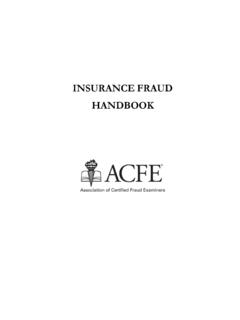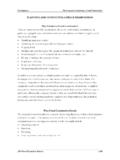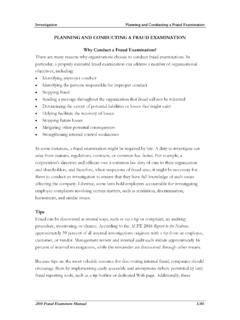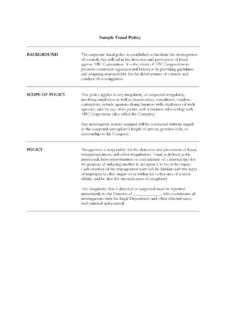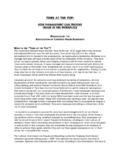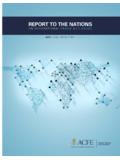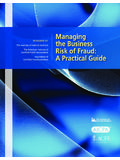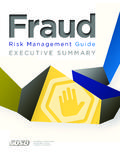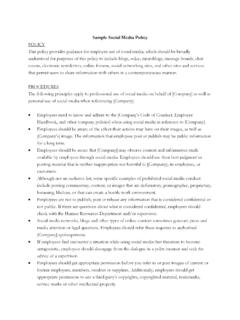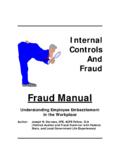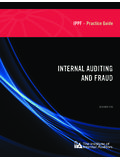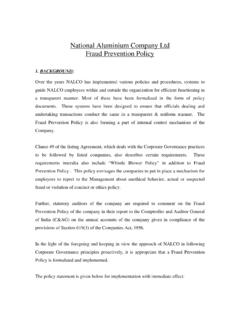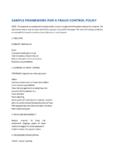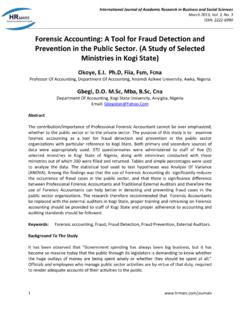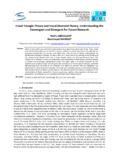Transcription of ON OCCUPATIONAL FRAUD AND ABUSE - acfe.com
1 2012 GLOBAL FRAUD STUDYREPORT TO THE NATIONS ON OCCUPATIONAL FRAUD AND ABUSE | 2012 REPORT TO THE NATIONS ON OCCUPATIONAL FRAUD AND ABUSE2 More than 15 years ago, the ACFE s founder and Chairman, Dr. Joseph T. Wells, CFE, CPA, conceptualized a groundbreaking research project to study the costs, methodologies and perpetrators of FRAUD within organizations. The result was the 1996 publication of the ACFE s first Report to the Nation on OCCUPATIONAL FRAUD and ABUSE . Since then, we have released six additional Reports that have each expanded our knowledge and understanding of the tremendous financial impact OCCUPATIONAL FRAUD and ABUSE has on businesses and organizations. We are proud to say that the information contained in the original Report and its successors has become the most authoritative and widely quoted body of research on OCCUPATIONAL data presented in our 2012 Report is based on 1,388 cases of OCCUPATIONAL FRAUD that were reported by the Certified FRAUD Examiners (CFEs) who investigated them.
2 These offenses occurred in nearly 100 countries on six continents, offering readers a view into the global nature of OCCUPATIONAL FRAUD . As in previous years, what is perhaps most striking about the data we gathered is how consistent the patterns of FRAUD are around the globe and over time. We believe this consistency reaffirms the value of our research efforts and the reliability of our findings as truly representative of the characteristics of OCCUPATIONAL fraudsters and their behalf of the ACFE, and in honor of its founder, Dr. Wells, I am pleased to present the 2012 Report to the Nations on OCCUPATIONAL FRAUD and ABUSE . It is my hope that practitioners, business and government organiza-tions, academics, the media and the general public throughout the world will find the information contained in this Report of value in their efforts to prevent, detect or simply understand the global economic impact of OCCUPATIONAL D. Ratley, CFEP resident and CEOA ssociation of Certified FRAUD ExaminersLetter from the President & CEO2012 REPORT TO THE NATIONS on OCCUPATIONAL FRAUD and ABUSE |3 Table of Contentsexecutive summary.
3 4introduction ..6the cost of OCCUPATIONAL FRAUD ..8 Distribution of LossesHow OCCUPATIONAL FRAUD is committed ..10 Asset Misappropriation Sub-Schemes Duration of FRAUD Schemesdetection of FRAUD schemes ..14 Initial Detection of OCCUPATIONAL Frauds Median Loss by Detection Method Source of Tips Impact of Hotlines Detection Method by Organization Size Detection Method by Scheme Type Detection Method by Region Victim organizations ..20 Geographical Location of Organizations Types of Organizations Size of Organizations Methods of FRAUD in Small Businesses Industry of Organizations Anti- FRAUD Controls at Victim Organizations Effectiveness of Controls Importance of Controls in Detecting or Limiting FRAUD Control Weaknesses that Contributed to Fraudperpetrators ..39 Perpetrator s Position The Impact of Collusion Perpetrator s Gender Perpetrator s Age Perpetrator s Tenure Perpetrator s Education Level Perpetrator s Department Perpetrator s Criminal and Employment History Behavioral Red Flags Displayed by Perpetratorscase Results.
4 61 Criminal Prosecutions Civil Suits Recovery of LossesMethodology ..64appendix: breakdown of Geographic Regions by country ..67 FRAUD prevention checklist ..69index ..70about the acFe ..74| 2012 REPORT TO THE NATIONS on OCCUPATIONAL FRAUD and abuseSummary of Findings Survey participants estimated that the typical organization loses 5% of its revenues to FRAUD each year. Applied to the 2011 Gross World Product, this figure translates to a potential pro-jected annual FRAUD loss of more than $ trillion. The median loss caused by the OCCUPATIONAL FRAUD cases in our study was $140,000. More than one-fifth of these cases caused losses of at least $1 million. The frauds reported to us lasted a median of 18 months before being detected. As in our previous studies, asset misappropria-tion schemes were by far the most common type of OCCUPATIONAL FRAUD , comprising 87% of the cases reported to us; they were also the least costly form of FRAUD , with a median loss of $120,000. Financial statement FRAUD schemes made up just 8% of the cases in our study, but caused the greatest median loss at $1 million.
5 Corruption schemes fell in the middle, occurring in just over one-third of reported cases and causing a median loss of $250,000. OCCUPATIONAL FRAUD is more likely to be detected by a tip than by any other method. The majority of tips reporting FRAUD come from employees of the victim organization. Corruption and billing schemes pose the greatest risks to organizations throughout the world. For all geographic regions, these two scheme types comprised more than 50% of the frauds reported to us. OCCUPATIONAL FRAUD is a significant threat to small businesses. The smallest organizations in our study suffered the largest median losses. These organizations typically employ fewer anti- FRAUD controls than their larger counterparts, which increases their vulnerability to FRAUD . As in our prior research, the industries most commonly victimized in our current study were the banking and financial services, government and public administration, and manufacturing sectors. The presence of anti- FRAUD controls is notably correlated with significant decreases in the cost and duration of OCCUPATIONAL FRAUD schemes.
6 Victim organizations that had implemented any of 16 common anti- FRAUD controls experienced considerably lower losses and time-to-detection than organizations lacking these controls. Perpetrators with higher levels of authority tend to cause much larger losses. The median loss among frauds committed by owner/ executives was $573,000, the median loss caused by managers was $180,000 and the median loss caused by employees was $60,000. The longer a perpetrator has worked for an organization, the higher FRAUD losses tend to be. Perpetrators with more than ten years of experience at the victim organization caused a median loss of $229,000. By comparison, the median loss caused by perpetrators who committed FRAUD in their first year on the job was only $25,000. The vast majority (77%) of all frauds in our study were committed by individuals working in one of six departments: accounting, opera-tions, sales, executive/upper management, customer service and purchasing. This distribu-tion was very similar to what we found in our 2010 study.
7 Most OCCUPATIONAL fraudsters are first-time offenders with clean employment histories. Approximately 87% of OCCUPATIONAL fraudsters had never been charged or convicted of a FRAUD -related offense, and 84% had never been punished or terminated by an employer for FRAUD -related conduct. 4 Executive SummaryMore than one-fifth of frauds in our study caused at least $1 million in REPORT TO THE NATIONS on OCCUPATIONAL FRAUD and ABUSE | In 81% of cases, the fraudster displayed one or more behavioral red flags that are often associated with fraudulent conduct. Living be-yond means (36% of cases), financial difficulties (27%), unusually close association with vendors or customers (19%) and excessive control issues (18%) were the most commonly observed behavioral warning signs. Nearly half of victim organizations do not re-cover any losses that they suffer due to FRAUD . As of the time of our survey, 49% of victims had not recovered any of the perpetrator s takings; this finding is consistent with our previ-ous research, which indicates that 40 50% of victim organizations do not recover any of their FRAUD -related The nature and threat of OCCUPATIONAL FRAUD is truly universal.
8 Though our research noted some regional differences in the methods used to com-mit FRAUD as well as organizational approaches to preventing and detecting it many trends and characteristics are similar regardless of where the FRAUD occurred. Providing individuals a means to report suspi-cious activity is a critical part of an anti- FRAUD program. FRAUD reporting mechanisms, such as hotlines, should be set up to receive tips from both internal and external sources and should allow anonymity and confidentiality. Management should actively encourage employees to report suspicious activity, as well as enact and emphasize an anti-retaliation policy. External audits should not be relied upon as an organization s primary FRAUD detection method. Such audits were the most commonly imple-mented control in our study; however, they de-tected only 3% of the frauds reported to us, and they ranked poorly in limiting FRAUD losses. While external audits serve an important purpose and can have a strong preventive effect on potential FRAUD , their usefulness as a means of uncovering FRAUD is limited.
9 Targeted FRAUD awareness training for employees and managers is a critical component of a well-rounded program for preventing and detecting FRAUD . Not only are employee tips the most com-mon way OCCUPATIONAL FRAUD is detected, but our research shows organizations that have anti- FRAUD training programs for employees, managers and executives experience lower losses and shorter frauds than organizations without such programs in place. At a minimum, staff members should be educated regarding what actions constitute FRAUD , how FRAUD harms everyone in the organization and how to report questionable activity. Our research continues to show that small busi-nesses are particularly vulnerable to FRAUD . These organizations typically have fewer resources than their larger counterparts, which often translates to fewer and less-effective anti- FRAUD controls. In addition, because they have fewer resources, the losses experienced by small businesses tend to have a greater impact than they would in larger organizations.
10 Managers and owners of small businesses should focus their anti- FRAUD efforts on the most cost-effective control mechanisms, such as hotlines, employee education and setting a proper ethical tone within the organization. Ad-ditionally, assessing the specific FRAUD schemes that pose the greatest threat to the business can help identify those areas that merit additional investment in targeted anti- FRAUD controls. Most fraudsters exhibit behavioral traits that can serve as warning signs of their actions. These red flags such as living beyond one s means or ex-hibiting excessive control issues generally will not be identified by traditional internal controls. Managers, employees and auditors should be educated on these common behavioral patterns and encouraged to consider them particularly when noted in tandem with other anomalies to help identify patterns that might indicate fraudulent activity. The cost of OCCUPATIONAL FRAUD both financially and to an organization s reputation can be acutely damaging.
